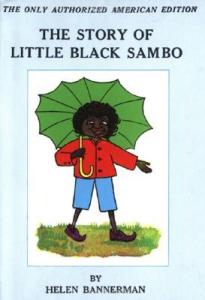Because there are so many tigers on the old plantations.

This book is only bad because of Helen Bannerman's original racist drawings and the names of the characters. The characters don't act in a particularly stereotypical way, and the message of the book isn't inherently bad. Clearly the story is set in India, and I don't know why Bannerman decided to draw the characters as awful stereotypes from the American South. There are no tigers in the Southern United States, and ghi (or ghee) is even stated to be from India. But the first sentence is, "Once upon a time there was a little black boy, and his name was Little Black Sambo." There's really nothing inherently wrong with that, except that his race is irrelevant to the story. Pointing out his race, and having his race be a part of his name, is just tacky. The name "Sambo" had already been in use for some time as a stereotypical "black" name, but it's hard to tell how derogatory the name was until after Bannerman's book became popular. The preface to the edition of the book I read says, "Sambo became, to some, a symbol of racism, and to others, he remained a long-remembered favorite."
The story: A little boy's mother makes him a jacket and some pants, and his dad buys him an umbrella and some pretty shoes. Then he goes out for a walk in the jungle and meets a tiger. The tiger says, "I'm gonna eat you," and the kid says, "Don't eat me! I'll give you my jacket." And so the tiger goes, "Okay." And then the boy meets another tiger who threatens him into giving the tiger his pants. Another tiger gets his shoes, although he protests, "What am I gonna do with two shoes? I've got four feet." And the kid says, "Put them on your ears," and the tiger's like, "What a great idea!" A fourth tiger takes the umbrella, after protesting that he can't hold it, and the kid tells him to tie a knot in his tail to hold it. At this point, the boy is sad, because he doesn't have any of his fancy clothes anymore (he doesn't seem to care that he's in his underwear). He hears the tigers coming, so he hides behind a tree. The tigers are fighting over which one of them is the prettiest, and they get so angry at each other that they take off all the fancy clothes and start fighting. They head towards the tree the boy was behind (he runs to hide behind the umbrella) and they get in a circle around it, each grabbing the tail of the tiger in front of him with his teeth. The boy goes, "Don't you want the clothes anymore? Let me know if you want them, otherwise I'm gonna take them." The tigers don't say anything because they don't want to let go of each other's tails, so the kid gets the clothes and wanders off. The tigers get so mad that they run around the tree faster and faster, until they turn into melted butter. Then the kid's father saunters by, sees the butter, and goes, "That looks like some great butter lying on the ground. I'm gonna take that home to my wife." The kids mom goes, "Hey, this is good, we'll all have pancakes for dinner." And the mother eats 27, the father eats 55, and the boy eats 169. The end.
That story, in and of itself, even with an African-American protagonist (in a jungle for some reason), has nothing inherently wrong with it. The child is the hero. There's nothing demeaning about his textual portrayal. I'm not sure if I'd describe what he does to the tigers as "outwitting" (they basically fall victim to their own pride without much intervention from him) unless you count him trading his clothes for his life. But like I said, without the illustrations and character names, there's nothing wrong with the story. And in fact, there are many retellings of the story with different illustrations that are perfectly fine books. Obviously, you could make it more racist if you tried, but without the racist elements and it's a perfectly serviceable, if a bit mediocre, story. The edition with Bannerman's original illustrations, like many of the early editions of the book with similarly racist illustrations by other artists, is bad. This is very uncomfortable for me to read as a white person, and I can't imagine what it must be like for a black person, especially a child, to see these caricatures. And it's not like they're great art, either. I could draw better than this. Even the tigers are weird, looking like some kind of cross between a tiger and a Chinese dragon. Very strange-looking.
I feel like the story wants to get across some message, but I'm not sure what it is. "Tigers will eat you unless you give them pretty clothes"? "Tigers are surprisingly fashion-conscious"? "Stay out of the way of anybody who's having a fight"? That one's not too bad. Maybe just "Pancakes are delicious."
Little Black Sambo
I first read this when I was 7 or 8 and had just learned to read. I loved the story for what it was - a good humoured often silly story about a smart and clever little boy who outwitted a bunch of big bullies and got rewarded for it. I often wanted to be like the hero and pull one over the schoolyard bullies that tormented me. I don't see anything wrong with what I learned from the book - which included learning that kids that didn't look like me could still be brave and smart kids and the good guys.